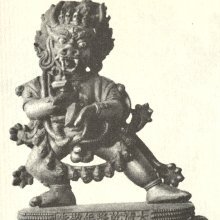Ti, Ṭi: 18 definitions
Introduction:
Ti means something in Buddhism, Pali, Hinduism, Sanskrit, the history of ancient India, Marathi, Jainism, Prakrit, Hindi, biology, Tamil. If you want to know the exact meaning, history, etymology or English translation of this term then check out the descriptions on this page. Add your comment or reference to a book if you want to contribute to this summary article.
Images (photo gallery)
(+3512 more images available)
In Hinduism
Vyakarana (Sanskrit grammar)
Source: archive.org: Uṇādi-Sūtras In The Sanskrit Grammatical TraditionṬi (टि).—One of the technical terms which have been used in the uṇādi-sūtras;—Ṭi is defined either as the final syllable beginning with a vowel or as part of a word consisting of the final vowel in a word and the consonants following the final vowel. This is what ‘aco’ntyādi ṭi’ (Pa. 1.1.64) means. This technical term is used in the uṇādi-sūtras in exactly the same sense.
Source: Wikisource: A dictionary of Sanskrit grammarṬi (टि).—The final syllable beginning with a vowel; part of a word consisting of the final vowel in a word and the consonants following the final vowel; cf अचेन्त्यादि टि (acentyādi ṭi) P. I. 1.64.
--- OR ---
Ti (ति).—(l) personal ending तिप् (tip) of the 3rd pers. sing.; (2) common term for the krt affixes क्तिन् (ktin) and क्तिच् (ktic) as also for the unadi affix ति (ti); see क्तिन् (ktin) and क्तिच् (ktic); (3) fem. affix ति (ti) added to the word युवन् (yuvan). e. g. युवतिः (yuvatiḥ) cf. P. IV. 1.77; (4) tad. affix ति (ti) as found in the words पङ्क्ति (paṅkti) and विंशति (viṃśati) cf. Kas. on P.V.1.59; (5) tad. affix added to the word पक्ष (pakṣa) in the sense of 'a root,' and to the words कम् (kam) and शम् (śam) in the sense of possession (मत्वर्थे (matvarthe)); e.g. पक्षतिः, कन्तिः, शान्तिः (pakṣatiḥ, kantiḥ, śāntiḥ), cf. Kas, on P. V.2.25, 138; (6) a technical term for the term गति (gati) in Panini's grammar, cf. उपसर्गाः क्रिया-योगे (upasargāḥ kriyā-yoge); गतिश्च (gatiśca) P. 1.4.59, 60. The term ति (ti) for गति (gati) is used in the Jainendra Vyakarana.

Vyakarana (व्याकरण, vyākaraṇa) refers to Sanskrit grammar and represents one of the six additional sciences (vedanga) to be studied along with the Vedas. Vyakarana concerns itself with the rules of Sanskrit grammar and linguistic analysis in order to establish the correct context of words and sentences.
In Buddhism
Theravada (major branch of Buddhism)
Source: Journey to Nibbana: Patthana Dhamati or iti means like this, as such
Theravāda is a major branch of Buddhism having the the Pali canon (tipitaka) as their canonical literature, which includes the vinaya-pitaka (monastic rules), the sutta-pitaka (Buddhist sermons) and the abhidhamma-pitaka (philosophy and psychology).
India history and geography
Source: Cologne Digital Sanskrit Dictionaries: Indian Epigraphical GlossaryTi.—(IE 8-1), abbreviation of tithi. Note: ti is defined in the “Indian epigraphical glossary” as it can be found on ancient inscriptions commonly written in Sanskrit, Prakrit or Dravidian languages.
--- OR ---
Ṭi.—(IE 8-1), abbreviation of ṭikar or ṭikkara, ‘a mound’. Note: ṭi is defined in the “Indian epigraphical glossary” as it can be found on ancient inscriptions commonly written in Sanskrit, Prakrit or Dravidian languages.

The history of India traces the identification of countries, villages, towns and other regions of India, as well as mythology, zoology, royal dynasties, rulers, tribes, local festivities and traditions and regional languages. Ancient India enjoyed religious freedom and encourages the path of Dharma, a concept common to Buddhism, Hinduism, and Jainism.
Biology (plants and animals)
Source: Google Books: CRC World Dictionary (Regional names)Ti in Hawaii is the name of a plant defined with Cordyline fruticosa in various botanical sources. This page contains potential references in Ayurveda, modern medicine, and other folk traditions or local practices It has the synonym Taetsia ferrea Medik., nom. illeg. (among others).
Example references for further research on medicinal uses or toxicity (see latin names for full list):
· Encyclopédie Méthodique, Botanique (1783)
· Theodora Speciosa (1786)
· Trees of Mumbai (1999)
· Genera Plantarum (1789)
· Novorum Actorum Academiae Caesareae Leopoldinae-Carolinae Naturae Curiosorum (1855)
· Systema Naturae, ed. 12 (1767)
If you are looking for specific details regarding Ti, for example diet and recipes, pregnancy safety, chemical composition, extract dosage, health benefits, side effects, have a look at these references.

This sections includes definitions from the five kingdoms of living things: Animals, Plants, Fungi, Protists and Monera. It will include both the official binomial nomenclature (scientific names usually in Latin) as well as regional spellings and variants.
Languages of India and abroad
Pali-English dictionary
Source: BuddhaSasana: Concise Pali-English Dictionaryiti : (ind.) thus. (used to point out something just mentioned or about to be mentioned, and to show that a sentence is finished). Very often its former i is elided and ti only is remaining. || īti (f.), calamity.
Source: Sutta: The Pali Text Society's Pali-English DictionaryTi°, (Vedic tris, Av. priś, Gr. triζ, Lat. ter (fr. ters›*tris, cp. testis›*tristo, trecenti›*tricenti), Icl. prisvar, Ohg. driror) base of numeral three in compn; consisting of three, threefold; in numerical cpds. also= three (3 times).
—kaṭuka threefold spices (kaṭuka-bhaṇḍa) VvA. 186; —gāvuta a distance of 3/4 of a league (i.e. about 2 miles), DhA. I, 108 (less than yojana, more than usabha), 131, 396; II, 43, 61, 64, 69; III, 202, 269; VvA. 227; B. on S. I, 52 (sarīra); —catu three or four DhA. I, 173; —cīvara (nt.) the 3 robes of a bhikkhu, consisting of: diguṇā saṅghāṭi, ekacciya uttarāsaṅga, ekacciya antaravāsaka Vin. I, 289, 296; II, 302. ticīvarena avippavāsa Vin. I, 109 sq.—Vism. 60, 66; DhA. IV, 23. —tālamattaṃ 3 palm-trees high DhA. II, 62. —daṇḍa 1. a tripod as one of the requisites of a hermit to place the water-pot on (kuṇḍikā) J. I, 8 (tidaṇḍakuṇḍikādike tāpasa-parikkhārā), 9 (hanging from the kāja); II, 317 (see tedaṇḍika).—2. part of a chariot A. IV, 191 (v. l. daṇḍa only). —diva the 3 heavens (that is the Tāvatiṃsa heaven) D. II, 167, 272 (tidivûpapanna); S. I, 96 (°ṃ ṭhānaṃ upeti), 181 (ākaṅkha-māno °ṃ anuttaraṃ). —pada (cp. Vedic tripad or tripād, Gr. tri/pous, Lat. tripes: tripod) consisting of 3 feet or (in prosody) of 3 padas Sn. 457 (w. ref. to metre Sāvittī); —(p)pala threefold Vism. 339; —pallattha “turning in 3 ways, ” i.e. skilled in all occupations (Kern, Toev. : zeer listig) J. I, 163 (of miga; Com. expl. as lying on 3 sides of its lair); —piṭaka the 3 Piṭakas Vism. 62, 241; DhA. I, 382; —peṭaka=tepiṭaka Miln. 90; tipeṭakin at Vin. V, 3; —maṇḍala (nt.) the 3 circles (viz. the navel & the 2 knees) Vin. II, 213 (°ṃ paṭicchādento parimaṇḍalaṃ nivāsento); cp. Vin. Texts I. 155; —yojana a distance of 3 leagues, i.e. 20 miles, or fig. a long dist.; Vism. 392 (tiyojanika setacchatta); DhA. II, 41 (°magga); VvA. 75 (°mattake vihāraṃ agamāsi); PvA. 216 (sā ca pokkharaṇī Vesaliyā °mattake hoti); °satika 300 cubits long J. II, 3; —loka the 3 worlds (i.e. kāma, rūpa, arūpa-loka) Sdhp. 29, 276, 491 (cp. tebhūmaka); —vagga consisting of 3 divisions or books DA. I, 2 (Dīghāgamo vaggato t. hoti); —(v)aṅgika having 3 aṅgas (of jhāna) Dhs. 161; —vassika for the 3 seasons (-gandha-sālibhattaṃ bhuñjantā) DhA. II, 9; J. I, 66 (id.); —vidha 3 fold, of sacrifice (yañña) D. I, 128, 134, 143; of aggi (fire) J. I, 4 & Miln. 97; Vism. 147 (°kalyāṇatā). —visākha a three-forked frown on the forehead S. I, 118; M. I, 109; —sandhi consisting of 3 spaces J. VI, 397 (tāya senāya Mithilā t. -parivāritā), explained as an army made up of elephants, chariots, cavalry, and infantry, with a space between each two. (Page 301)

Pali is the language of the Tipiṭaka, which is the sacred canon of Theravāda Buddhism and contains much of the Buddha’s speech. Closeley related to Sanskrit, both languages are used interchangeably between religions.
Marathi-English dictionary
Source: DDSA: The Molesworth Marathi and English Dictionaryti (ति).—(tīna) Three. Only as a prefix. Ex. timaja- lā, tikōnī Of three stories or corners.
--- OR ---
tī (ती).—pron She: or that (person or thing expressed by a word of the feminine gender). 2 Used contemptuously in designating a male: as myāṃ tilā khūba ṭhakavilēṃ.
Source: DDSA: The Aryabhusan school dictionary, Marathi-Englishtī (ती).—pro She; that.
--- OR ---
tī (ती).—or -
--- OR ---
tī (ती).—or -
--- OR ---
ṭī (टी).—or-
--- OR ---
tī (ती).—or-
Marathi is an Indo-European language having over 70 million native speakers people in (predominantly) Maharashtra India. Marathi, like many other Indo-Aryan languages, evolved from early forms of Prakrit, which itself is a subset of Sanskrit, one of the most ancient languages of the world.
Sanskrit dictionary
Source: DDSA: The practical Sanskrit-English dictionaryTi (ति).—I. 1 P. (temati, timita) To make wet or damp, moisten. -II. 4 P. (timyati)
1) To become wet.
2) To become quiet or tranquil, be calm.
Derivable forms: tim (तिम्).
--- OR ---
Tī (ती).—4 P. (tīmyati) To be wet or moist.
Derivable forms: tīm (तीम्).
Source: Cologne Digital Sanskrit Dictionaries: Monier-Williams Sanskrit-English DictionaryTi (ति):—for iti (after kā), [Śatapatha-brāhmaṇa xi, 6, 1, 3 ff.]
[Sanskrit to German]
Sanskrit, also spelled संस्कृतम् (saṃskṛtam), is an ancient language of India commonly seen as the grandmother of the Indo-European language family (even English!). Closely allied with Prakrit and Pali, Sanskrit is more exhaustive in both grammar and terms and has the most extensive collection of literature in the world, greatly surpassing its sister-languages Greek and Latin.
Hindi dictionary
Source: DDSA: A practical Hindi-English dictionaryTi (ति):——an allomorph of [tīna] used in compounds, e.g. [tigunā/tikonā], etc.
...
Prakrit-English dictionary
Source: DDSA: Paia-sadda-mahannavo; a comprehensive Prakrit Hindi dictionary1) Ti (ति) in the Prakrit language is related to the Sanskrit word: Triḥ.
2) Ti (ति) also relates to the Sanskrit word: Tri.
Prakrit is an ancient language closely associated with both Pali and Sanskrit. Jain literature is often composed in this language or sub-dialects, such as the Agamas and their commentaries which are written in Ardhamagadhi and Maharashtri Prakrit. The earliest extant texts can be dated to as early as the 4th century BCE although core portions might be older.
Kannada-English dictionary
Source: Alar: Kannada-English corpusṬī (ಟೀ):—
1) [noun] the evergreen plant Thea sinensis (= Camelia thea, = C. sinensis) of Theaceae family.
2) [noun] its dried and prepared leaves used to make a beverage; tea.
3) [noun] the beverage made using these leaves.
Kannada is a Dravidian language (as opposed to the Indo-European language family) mainly spoken in the southwestern region of India.
Nepali dictionary
Source: unoes: Nepali-English DictionaryTī (ती):—pron. those; that (when the honorifics as the same level of यनी, उनी, तिनी [yanī, unī, tinī ] come after);
Nepali is the primary language of the Nepalese people counting almost 20 million native speakers. The country of Nepal is situated in the Himalaya mountain range to the north of India.
See also (Relevant definitions)
Starts with (+5675): Campakapupphiya, Takkisu, Teendharke, Teenpate, Teetas, Thillai, Thiruccerai, Thiruparankundram, Thiruthondathogai, Thiruvananthapuram, Thiruvidaimarudur, Ti ba, Ti bois de senteur, Ti bush, Ti chen, Ti chih, Ti chin, Ti fey, Ti fu, Ti fu jung.
Ends with (+9980): A-campirannatacamati, A-karpaviputi, Aadavotti, Aagasti, Aagyapti, Aanakoranti, Aanayaviratti, Aarbhati, Aarti, Aatru netti, Aatti, Ab bhantal buti, Abaddhadrishti, Abadheti, Abadhutanubhuti, Abamdhaniti, Abandhati, Abanti, Abbahati, Abbeti.
Full-text (+59236): Tim, Dhi, Pati, Kati, Jati, Yuvakhalati, Mahamati, Bhrikuti, Asantati, Kapatin, Troti, Bhrakuti, Nirheti, Hinajati, Durmati, Skhalanmati, Vikriti, Ghorakriti, Viparitagati, Utpatin.
Relevant text
One of your search terms exceeds the minimun character amount per search term. This amount currently equals 2.
No search results for Ti, Dee, Dhi, Di, Thee, Thi, Ṭi, Tī, Ṭī; (plurals include: Dees, Dhis, Thees, This) in any book or story.
Related products
(+505 more products available)











